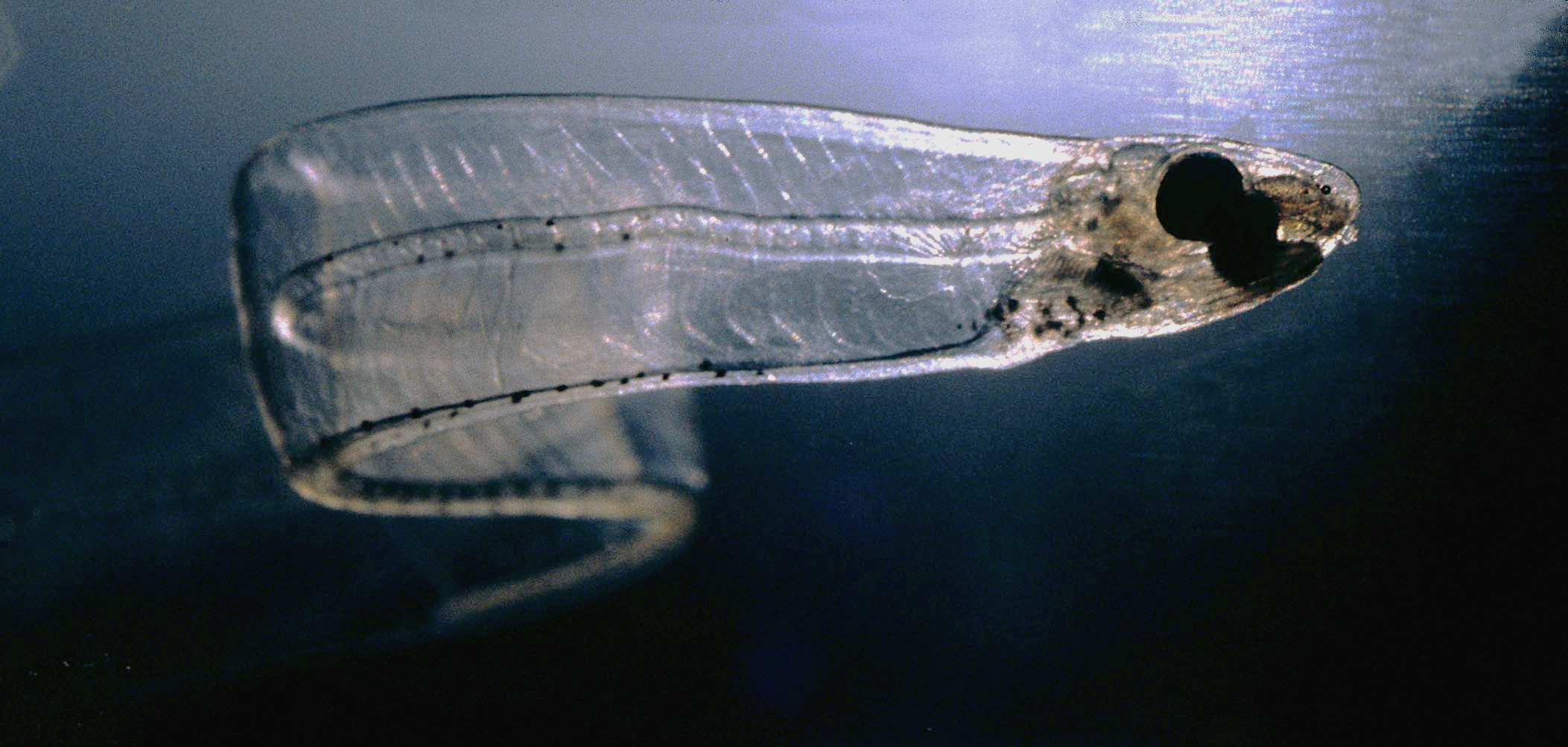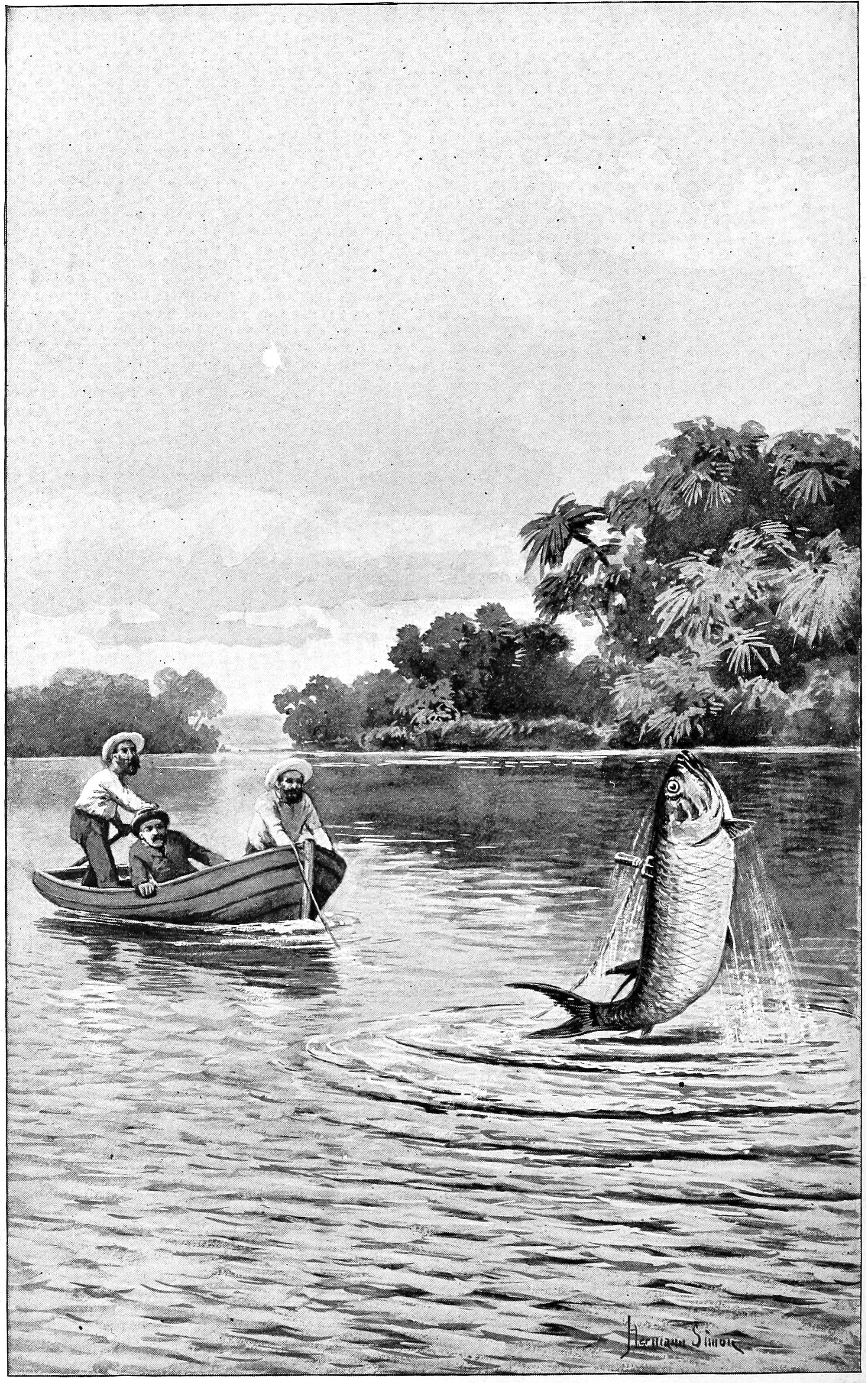|
Elopomorpha
The superorder Elopomorpha contains a variety of types of fishes that range from typical silvery-colored species, such as the tarpons and ladyfishes of the Elopiformes and the bonefishes of the Albuliformes, to the long and slender, smooth-bodied eels of the Anguilliformes. The one characteristic uniting this group of fishes is they all have leptocephalus larvae, which are unique to the Elopomorpha. No other fishes have this type of larvae. Taxonomy The Elopomorpha are a group of teleost fishes and are separated into several orders. * Genus †'' Bullichthys'' Mayrincka, Britob & Otero 2010 * Genus †'' Eichstaettia'' Arratia 1987 * Genus †'' Eoenchelys'' Lu 1994 * Genus †'' Elopomorphorum'' Weiler ex Martin & Weiler 1954 tolith* Order Elopiformes Gosline 1960 ** Family † Anaethaliidae Gaudant 1968 ** Suborder Elopoidei *** Family Protelopidae de Saint Seine 1949 *** Family Elopidae Bonaparte 1832/Valenciennes 1847 ( tenpounders, ladyfishes) *** Family Megalopidae J ... [...More Info...] [...Related Items...] OR: [Wikipedia] [Google] [Baidu] |
Leptocephalus
Leptocephalus (meaning "slim head") is the flat and transparent larva of the eel, marine eels, and other members of the superorder Elopomorpha. This is one of the most diverse groups of teleosts, containing 801 species in 4 orders, 24 families, and 156 genera. This group is thought to have arisen in the Cretaceous period over 140 million years ago.Inuoe, Jun, M. Miya, et al. “Mitogenomic evidence for the monophyly of elopomorph fishes (Teleostei) and the evolutionary origin of the leptocephalus larva.” Molecular Phylogenetics and Evolution 32 (2004): 274-286. Web. 2 Nov. 2012. Fishes with a leptocephalus larval stage include the most familiar eels such as the conger, moray eel, and garden eel as well as members of the family Anguillidae, plus more than 10 other families of lesser-known types of marine eels. These are all true eels of the order Anguilliformes. Leptocephali of eight species of eels from the South Atlantic Ocean were described by Meyer-Rochow The fishes ... [...More Info...] [...Related Items...] OR: [Wikipedia] [Google] [Baidu] |
Teleostei
Teleostei (; Greek ''teleios'' "complete" + ''osteon'' "bone"), members of which are known as teleosts ), is, by far, the largest infraclass in the class Actinopterygii, the ray-finned fishes, containing 96% of all extant species of fish. Teleosts are arranged into about 40 orders and 448 families. Over 26,000 species have been described. Teleosts range from giant oarfish measuring or more, and ocean sunfish weighing over , to the minute male anglerfish ''Photocorynus spiniceps'', just long. Including not only torpedo-shaped fish built for speed, teleosts can be flattened vertically or horizontally, be elongated cylinders or take specialised shapes as in anglerfish and seahorses. The difference between teleosts and other bony fish lies mainly in their jaw bones; teleosts have a movable premaxilla and corresponding modifications in the jaw musculature which make it possible for them to protrude their jaws outwards from the mouth. This is of great advantage, enabling them ... [...More Info...] [...Related Items...] OR: [Wikipedia] [Google] [Baidu] |
Bullichthys
''Bullichthys'' is an extinct genus of albuliform fish which existed in the Romualdo Formation, Brazil during the Early Cretaceous (Albian The Albian is both an age of the geologic timescale and a stage in the stratigraphic column. It is the youngest or uppermost subdivision of the Early/Lower Cretaceous Epoch/ Series. Its approximate time range is 113.0 ± 1.0 Ma to 100.5 ± 0 ...) period.Diogo Mayrinck, Paulo M. Brito, Olga Otero (2010)"A new albuliform (Teleostei: Elopomorpha) from the Lower Cretaceous Santana Formation, Araripe Basin, northeastern Brazil".Cretaceous Research 31 (2): 227-236. . The type species is ''B. santanensis''. References Albuliformes Prehistoric ray-finned fish genera Cretaceous bony fish Early Cretaceous fish Albian life Prehistoric fish of South America Early Cretaceous animals of South America Cretaceous Brazil Fossils of Brazil Romualdo Formation Fossil taxa described in 2010 {{albuliformes-stub ... [...More Info...] [...Related Items...] OR: [Wikipedia] [Google] [Baidu] |
Tarpon
Tarpons are fish of the genus ''Megalops''. They are the only members of the family Megalopidae. Of the two species, one (''M. atlanticus'') is native to the Atlantic, and the other (''M. cyprinoides'') to the Indo-Pacific Oceans. Species and habitats The two species of tarpons are ''M. atlanticus'' (Atlantic tarpon) and ''M. cyprinoides'' (Indo-Pacific tarpon). ''M. atlanticus'' is found on the western Atlantic coast from Virginia to Brazil, throughout the Caribbean and the coast of the Gulf of Mexico. Tarpons are also found along the eastern Atlantic coast from Senegal to South Angola." Megalops atlanticus", www.fishbase.org, 11 February 2010. ''M. cyprinoides'' is found along the eastern African coast, throughout Southeast Asia, Japan, Tahiti, and Australia. Both species are found in both marine and freshwater habitats, usually ascending rivers to access freshwater marshes." Megalops cyprinoides", www.fishbase.org, 11 February 2010. They are able to survive in b ... [...More Info...] [...Related Items...] OR: [Wikipedia] [Google] [Baidu] |
Tarpon (PSF)
Tarpons are fish of the genus ''Megalops''. They are the only members of the family Megalopidae. Of the two species, one (''M. atlanticus'') is native to the Atlantic, and the other (''M. cyprinoides'') to the Indo-Pacific Oceans. Species and habitats The two species of tarpons are ''M. atlanticus'' (Atlantic tarpon) and ''M. cyprinoides'' (Indo-Pacific tarpon). ''M. atlanticus'' is found on the western Atlantic coast from Virginia to Brazil, throughout the Caribbean and the coast of the Gulf of Mexico. Tarpons are also found along the eastern Atlantic coast from Senegal to South Angola." Megalops atlanticus", www.fishbase.org, 11 February 2010. ''M. cyprinoides'' is found along the eastern African coast, throughout Southeast Asia, Japan, Tahiti, and Australia. Both species are found in both marine and freshwater habitats, usually ascending rivers to access freshwater marshes." Megalops cyprinoides", www.fishbase.org, 11 February 2010. They are able to survive in brackis ... [...More Info...] [...Related Items...] OR: [Wikipedia] [Google] [Baidu] |
Megalopidae
Tarpons are fish of the genus ''Megalops''. They are the only members of the family Megalopidae. Of the two species, one (''M. atlanticus'') is native to the Atlantic, and the other (''M. cyprinoides'') to the Indo-Pacific Oceans. Species and habitats The two species of tarpons are ''M. atlanticus'' (Atlantic tarpon) and ''M. cyprinoides'' (Indo-Pacific tarpon). ''M. atlanticus'' is found on the western Atlantic coast from Virginia to Brazil, throughout the Caribbean and the coast of the Gulf of Mexico. Tarpons are also found along the eastern Atlantic coast from Senegal to South Angola." Megalops atlanticus", www.fishbase.org, 11 February 2010. ''M. cyprinoides'' is found along the eastern African coast, throughout Southeast Asia, Japan, Tahiti, and Australia. Both species are found in both marine and freshwater habitats, usually ascending rivers to access freshwater marshes." Megalops cyprinoides", www.fishbase.org, 11 February 2010. They are able to survive in brackish wa ... [...More Info...] [...Related Items...] OR: [Wikipedia] [Google] [Baidu] |
Ladyfish
The Elopidae are a family of ray-finned fish containing a single living genus '' Elops''. They are commonly known as ladyfish, skipjacks, jack-rashes, or tenpounders. The ladyfish are a coastal-dwelling fish found throughout the tropical and subtropical regions, occasionally venturing into temperate waters.Adams, A. J., Horodysky, A. Z., McBride, R. S., Guindon, K., Shenker, J., MacDonald, T. C., Harwell, H. D., Ward, R., and Carpenter, K. Global conservation status and research needs for tarpons (Megalopidae), ladyfishes (Elopidae) and bonefishes (Albulidae). Fish and Fisheries (online, early view as of 2013). http://onlinelibrary.wiley.com/doi/10.1111/faf.12017/abstract Spawning takes place at sea, and the fish larvae migrate inland entering brackish waters. Their food is smaller fish and crustaceans (shrimp). Typically throughout the species, the maximum size is and the maximum weight . The body is fusiform (tapering spindle shape) and oval in cross-section; being slightly l ... [...More Info...] [...Related Items...] OR: [Wikipedia] [Google] [Baidu] |
Tenpounder
The Elopidae are a family of ray-finned fish containing a single living genus ''Elops''. They are commonly known as ladyfish, skipjacks, jack-rashes, or tenpounders. The ladyfish are a coastal-dwelling fish found throughout the tropical and subtropical regions, occasionally venturing into temperate waters.Adams, A. J., Horodysky, A. Z., McBride, R. S., Guindon, K., Shenker, J., MacDonald, T. C., Harwell, H. D., Ward, R., and Carpenter, K. Global conservation status and research needs for tarpons (Megalopidae), ladyfishes (Elopidae) and bonefishes (Albulidae). Fish and Fisheries (online, early view as of 2013). http://onlinelibrary.wiley.com/doi/10.1111/faf.12017/abstract Spawning takes place at sea, and the fish larvae migrate inland entering brackish waters. Their food is smaller fish and crustaceans ( shrimp). Typically throughout the species, the maximum size is and the maximum weight . The body is fusiform (tapering spindle shape) and oval in cross-section; being slightly la ... [...More Info...] [...Related Items...] OR: [Wikipedia] [Google] [Baidu] |
Elopidae
The Elopidae are a family of ray-finned fish containing a single living genus '' Elops''. They are commonly known as ladyfish, skipjacks, jack-rashes, or tenpounders. The ladyfish are a coastal-dwelling fish found throughout the tropical and subtropical regions, occasionally venturing into temperate waters.Adams, A. J., Horodysky, A. Z., McBride, R. S., Guindon, K., Shenker, J., MacDonald, T. C., Harwell, H. D., Ward, R., and Carpenter, K. Global conservation status and research needs for tarpons (Megalopidae), ladyfishes (Elopidae) and bonefishes (Albulidae). Fish and Fisheries (online, early view as of 2013). http://onlinelibrary.wiley.com/doi/10.1111/faf.12017/abstract Spawning takes place at sea, and the fish larvae migrate inland entering brackish waters. Their food is smaller fish and crustaceans (shrimp). Typically throughout the species, the maximum size is and the maximum weight . The body is fusiform (tapering spindle shape) and oval in cross-section; being slightly l ... [...More Info...] [...Related Items...] OR: [Wikipedia] [Google] [Baidu] |
Albulidae
Albulidae is a family of fish, commonly known as the bonefishes, that are popular as game fish in Florida, select locations in the South Pacific and the Bahamas (where two bonefish are featured on the 10-cent coin) and elsewhere. The family is small, with 11 species in 3 genera.Hidaka, K., Tsukamoto, Y. & Iwatsuki, Y. (2016): ''Nemoossis'', a new genus for the eastern Atlantic long-fin bonefish ''Pterothrissus belloci'' Cadenat 1937 and a redescription of ''P. gissu'' Hilgendorf 1877 from the northwestern Pacific. ''Ichthyological Research, 64 (1): 45–53.'' Presently, the bonefishes are in their own order: Albuliformes . The families Halosauridae and Notacanthidae were previously classified in this order, but are now, according to FishBase, given their own order Notacanthiformes. The largest bonefish caught in the Western Hemisphere is a 16-pound, 3 ounce example caught off Islamorada, Florida, on March 19, 2007. Description ''Albula'' The bonefishes' closest relatives are the ... [...More Info...] [...Related Items...] OR: [Wikipedia] [Google] [Baidu] |
Japanese Gissu
''Pterothrissus gissu'', also known as the Japanese gissu, is a species of ray-finned fish in the family Albulidae. The Japanese gissu is a rare fish that is distributed in deep water off northwest Pacific Ocean. This fish is known to pass through a leptocephalus larval stage, but only metamorphosed (after reaching the fully grown stage) specimens have been available.Tsukamoto, Y. (2002): Leptocephalus larvae of ''Pterothrissus gissu'' collected from the Kuroshio–Oyashio transition region of the western North Pacific, with comments on its metamorphosis. ''Ichthyological Research, 49 (3): 267-269.'' This species is the only member of its genus Genus ( plural genera ) is a taxonomic rank used in the biological classification of living and fossil organisms as well as viruses. In the hierarchy of biological classification, genus comes above species and below family. In binomial nom ....Hidaka, K., Tsukamoto, Y. & Iwatsuki, Y. (2016): ''Nemoossis'', a new genus for the east ... [...More Info...] [...Related Items...] OR: [Wikipedia] [Google] [Baidu] |
Eichstaettia
''Eichstaettia'' is an extinct genus of prehistoric bony fish that lived during the early Toarcian stage of the Early Jurassic epoch. See also * Prehistoric fish The evolution of fish began about 530 million years ago during the Cambrian explosion. It was during this time that the early chordates developed the skull and the vertebral column, leading to the first craniates and vertebrates. The first fis ... * List of prehistoric bony fish References Early Jurassic fish Elopiformes {{Elopiformes-stub ... [...More Info...] [...Related Items...] OR: [Wikipedia] [Google] [Baidu] |
.png)



